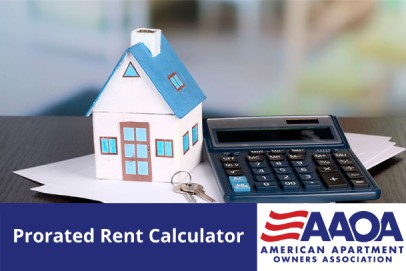Prorated Rent Calculator

It pays to be flexible in these cases — literally. Landlords know that the longer a property sits vacant, the more money you’re losing each day. If a tenant requests to move in sooner, it’s in your best interest to use prorated rent to help get them into the property faster without losing profits.
To make accounting easier, most landlords prefer to start leases on the first of the month. In a prorated situation, the best option is to allow the tenant to move in on the 15th or 25th. Then, you can charge them for each day they occupy the rental property.
To ensure you’re being fair to prospective tenants, it’s essential that you understand how to accurately calculate prorated rent.
What is prorated rent?
Prorated rent is pretty straightforward. It’s the amount you charge a renter based on the number of days that they are occupying your rental unit. The key is to charge a daily rate (per day) rather than a weekly or monthly rate.
Basically, the prorated rent enables a tenant to pay for only the percentage of time that they’re in your unit. Below are some examples of when a landlord or property manager may request a prorated rent payment:
- A new tenant wants to begin their lease early, but not a full 30 days before the first of the month.
- A current tenant requests to remain in the unit a few days or a couple of weeks past the end date of their lease agreement.
- Due to property damage (ex. From a storm), the existing tenant needs to temporarily move out while repairs are completed.
- A landlord decides to rent for short-term use to prevent extended vacancies in the unit.
Make it easy: Use AAOA’S prorated rent calculator
We’ve created a prorated rent calculator to help you determine the most accurate amount to charge for prorated rent. Quickly crunch the numbers without any hassle or doubts!
Simply fill in your numbers and gain access to an instant prorated rent amount:
Move-In Rent Calculator
1st Month's Prorated Rent
0 USD
Total Move-In Costs
0 USD
Move-Out Rent Calculator
Move-Out Prorated Rent
0 USD
Different ways to manually calculate prorated rent
Having access to a prorated rent calculator is great, but it’s also important that you understand why and how your prorated rent payments are calculated. How you choose to calculate prorated rent may depend on multiple factors, including:
- Personal financial goals
- Local or state laws and regulations
If you’re unsure of what your real estate market requirements are for prorating rent in your area, reach out to a real estate attorney with any and all questions.
Being able to give a clear, concise explanation for how prorated rent is calculated is a fundamental part of your tenant and landlord relationship that builds transparency and trust. You should also be able to explain how the prorated amount is rounded up during calculations.
Typically, landlords will round up if the third decimal point is between five through nine or round down if it’s between zero through four. These details may never come up when actually making arrangements with your new or existing tenant, but it’s always better to be upfront and honest when money is involved.
Below are two ways to calculate prorated rent:
Calculate based on the number of days in a month
This method has a major benefit for tenants: It’s easy to explain. Simply take your typical monthly rent and divide it by the number of days in that month. Then, take this amount and multiply it by the number of days that the tenant will be occupying your property.
(Monthly rent / # of days in the month) x (# of days tenant will occupy the property) = Total Prorated Rent
For example, if the tenant is moving in late on the 25th of September and the full rent amount is $1200, the calculation will look like this:
(1200 / 30) x (5) = 200
$200 would be the prorated rent amount for this tenant.
Remember: Each calendar month has its own number of days, so always make sure you use the month that the tenant is moving in or out of the apartment.
Calculate based on the number of days in a year
This method may be better for tenants who lease your property for longer than a year. To calculate the prorated amount, take the full monthly rent and multiply it by 12 (total number of months) to determine the yearly rent. Take the yearly amount and divide it by 365 (number of days in a year), which will yield the daily rent. With this number, you can then calculate the prorated amount by multiplying daily rent by the number of days that the tenant is occupying your unit.
[(Monthly rent x 12) / 365] x # of days tenant occupies your unit = Total Prorated Rent
For example, if the tenant is moving in late on the 25th of September and the full rent amount is $1200, the calculation will look like this:
(1200 x 12) / 365 x 5 = 197
$197 would be the prorated rent amount for this tenant.
Calculated based on a banker’s month or 30-day standard
Some landlords may prefer to simplify the prorated calculation based on the number of days in a month by unilaterally using a banker’s month, or 30 days. This means that no matter what month the tenant is occupying your property, the number of days will always be set to 30.
(Monthly rent / 30) x (# of days tenant will occupy the property) = Total Prorated Rent
Each method has its own benefits, so it’s up to each landlord to decide which one works best for their property.
How do you collect prorated rent?
For most tenants, rent is collected on the first day of the month, unless the lease agreement states otherwise. However, when prorated rent payments enter the picture, it can be confusing for both renters and landlords. Specifically, when is the prorated rent due?
With new tenants, they’ve already paid the first month’s rent after signing the lease. So if they move in early, you can ask them to submit the prorated rent amount on the first of the next month. For example:
If they move in on August 25th, they should be expected to pay the prorated rent on September 1st. They would then pay their first full month’s rent on the second month, October 1st.
To ensure your tenants are up to the task of prorated rent, utilize our tenant credit check to see if they have any history of non-payments or delinquencies.
Each landlord and property manager can proceed with prorated payments differently, though. Just ensure that your tenant understands and agrees with your chosen specifications and that you’re not breaking any local housing laws.
Join AAOA today
Want to streamline your business processes and find the right tenants for your property? AAOA offers industry-leading tenant screening services to help you make the most informed decision possible.















 Accessibility
Accessibility